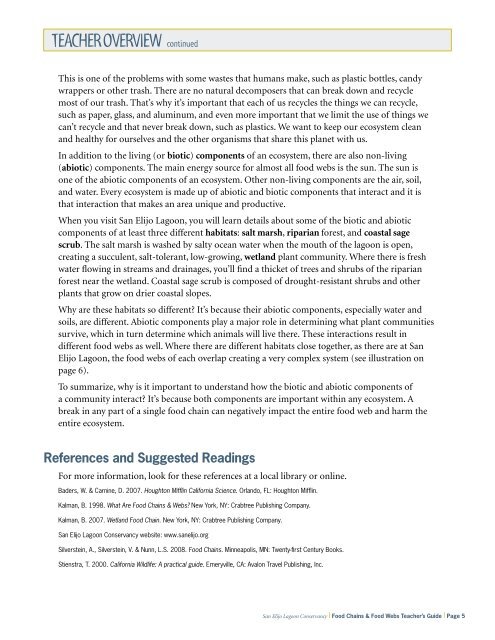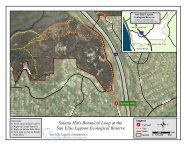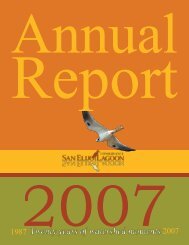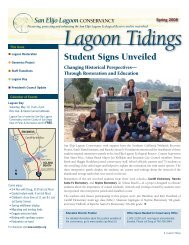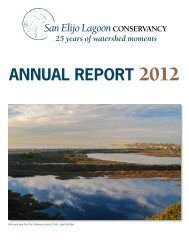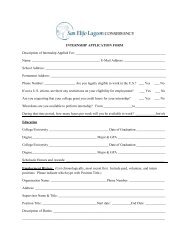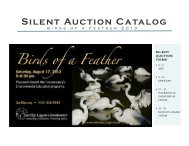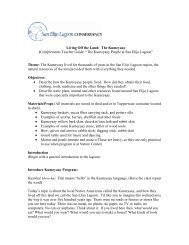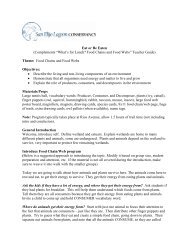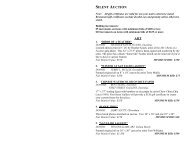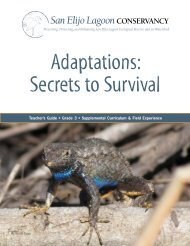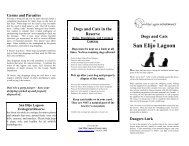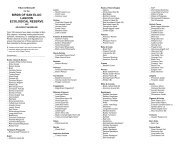Food Chains and Food Webs - San Elijo Lagoon Conservancy
Food Chains and Food Webs - San Elijo Lagoon Conservancy
Food Chains and Food Webs - San Elijo Lagoon Conservancy
You also want an ePaper? Increase the reach of your titles
YUMPU automatically turns print PDFs into web optimized ePapers that Google loves.
TEACHER OVERVIEW continued<br />
This is one of the problems with some wastes that humans make, such as plastic bottles, c<strong>and</strong>y<br />
wrappers or other trash. There are no natural decomposers that can break down <strong>and</strong> recycle<br />
most of our trash. That’s why it’s important that each of us recycles the things we can recycle,<br />
such as paper, glass, <strong>and</strong> aluminum, <strong>and</strong> even more important that we limit the use of things we<br />
can’t recycle <strong>and</strong> that never break down, such as plastics. We want to keep our ecosystem clean<br />
<strong>and</strong> healthy for ourselves <strong>and</strong> the other organisms that share this planet with us.<br />
In addition to the living (or biotic) components of an ecosystem, there are also non-living<br />
(abiotic) components. The main energy source for almost all food webs is the sun. The sun is<br />
one of the abiotic components of an ecosystem. Other non-living components are the air, soil,<br />
<strong>and</strong> water. Every ecosystem is made up of abiotic <strong>and</strong> biotic components that interact <strong>and</strong> it is<br />
that interaction that makes an area unique <strong>and</strong> productive.<br />
When you visit <strong>San</strong> <strong>Elijo</strong> <strong>Lagoon</strong>, you will learn details about some of the biotic <strong>and</strong> abiotic<br />
components of at least three different habitats: salt marsh, riparian forest, <strong>and</strong> coastal sage<br />
scrub. The salt marsh is washed by salty ocean water when the mouth of the lagoon is open,<br />
creating a succulent, salt-tolerant, low-growing, wetl<strong>and</strong> plant community. Where there is fresh<br />
water flowing in streams <strong>and</strong> drainages, you’ll find a thicket of trees <strong>and</strong> shrubs of the riparian<br />
forest near the wetl<strong>and</strong>. Coastal sage scrub is composed of drought-resistant shrubs <strong>and</strong> other<br />
plants that grow on drier coastal slopes.<br />
Why are these habitats so different? It’s because their abiotic components, especially water <strong>and</strong><br />
soils, are different. Abiotic components play a major role in determining what plant communities<br />
survive, which in turn determine which animals will live there. These interactions result in<br />
different food webs as well. Where there are different habitats close together, as there are at <strong>San</strong><br />
<strong>Elijo</strong> <strong>Lagoon</strong>, the food webs of each overlap creating a very complex system (see illustration on<br />
page 6).<br />
To summarize, why is it important to underst<strong>and</strong> how the biotic <strong>and</strong> abiotic components of<br />
a community interact? It’s because both components are important within any ecosystem. A<br />
break in any part of a single food chain can negatively impact the entire food web <strong>and</strong> harm the<br />
entire ecosystem.<br />
References <strong>and</strong> Suggested Readings<br />
For more information, look for these references at a local library or online.<br />
Baders, W. & Carnine, D. 2007. Houghton Mifflin California Science. Orl<strong>and</strong>o, FL: Houghton Mifflin.<br />
Kalman, B. 1998. What Are <strong>Food</strong> <strong>Chains</strong> & <strong>Webs</strong>? New York, NY: Crabtree Publishing Company.<br />
Kalman, B. 2007. Wetl<strong>and</strong> <strong>Food</strong> Chain. New York, NY: Crabtree Publishing Company.<br />
<strong>San</strong> <strong>Elijo</strong> <strong>Lagoon</strong> <strong>Conservancy</strong> website: www.sanelijo.org<br />
Silverstein, A., Silverstein, V. & Nunn, L.S. 2008. <strong>Food</strong> <strong>Chains</strong>. Minneapolis, MN: Twenty-first Century Books.<br />
Stienstra, T. 2000. California Wildlife: A practical guide. Emeryville, CA: Avalon Travel Publishing, Inc.<br />
<strong>San</strong> <strong>Elijo</strong> <strong>Lagoon</strong> <strong>Conservancy</strong> | <strong>Food</strong> <strong>Chains</strong> & <strong>Food</strong> <strong>Webs</strong> Teacher’s Guide | Page 5


